History and Art Collide at Burwell-Morgan Mill
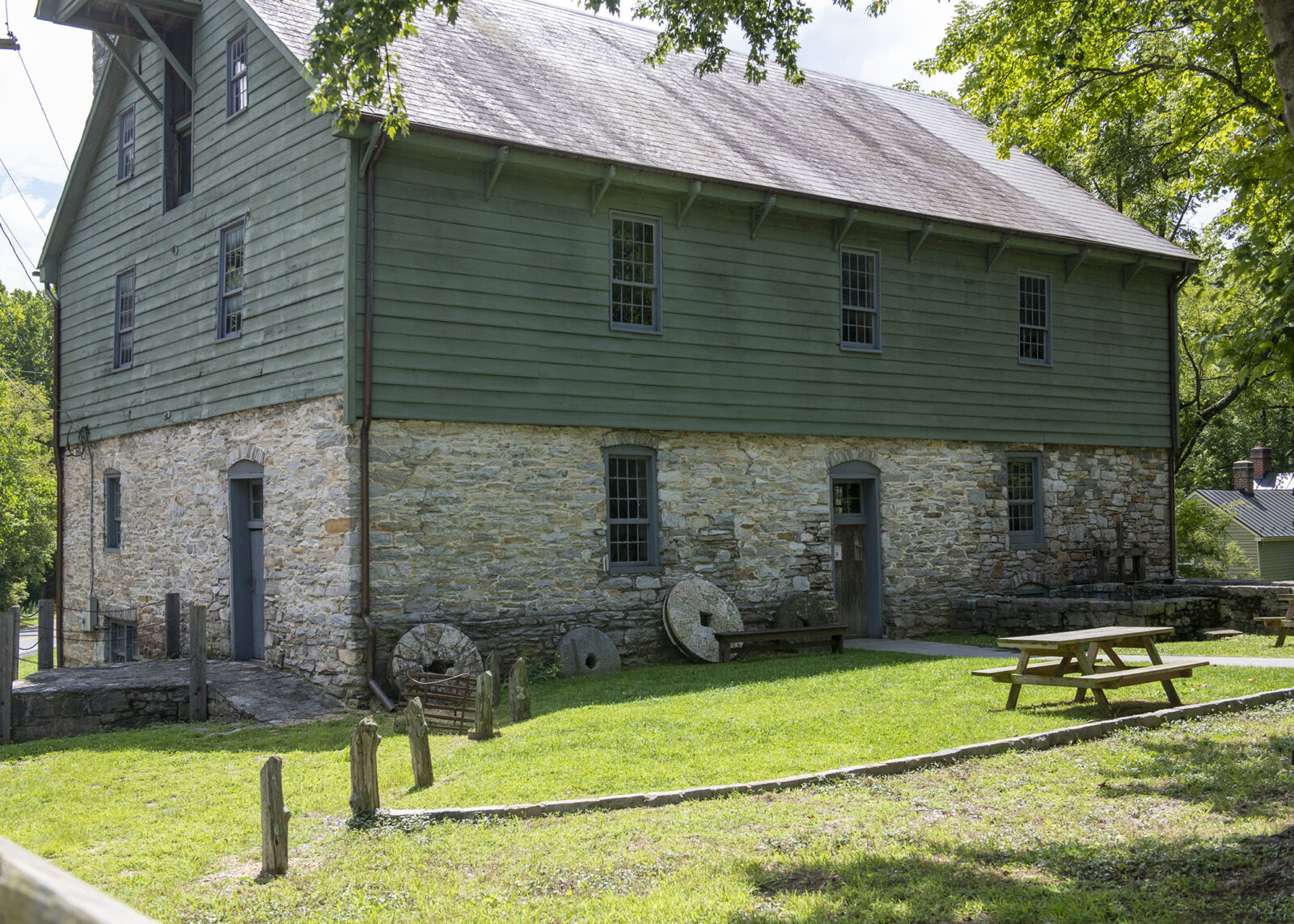
Written by Heidi Baumstark
In 1782, during the final stages of the Revolutionary War, two men struck out on a business venture – the Burwell-Morgan Mill – which became one of the most successful merchant mills in the colony of Virginia. Continuing a 200-plus-year legacy in the heart of the Shenandoah Valley, its wheels still turn today to produce freshly ground grain.
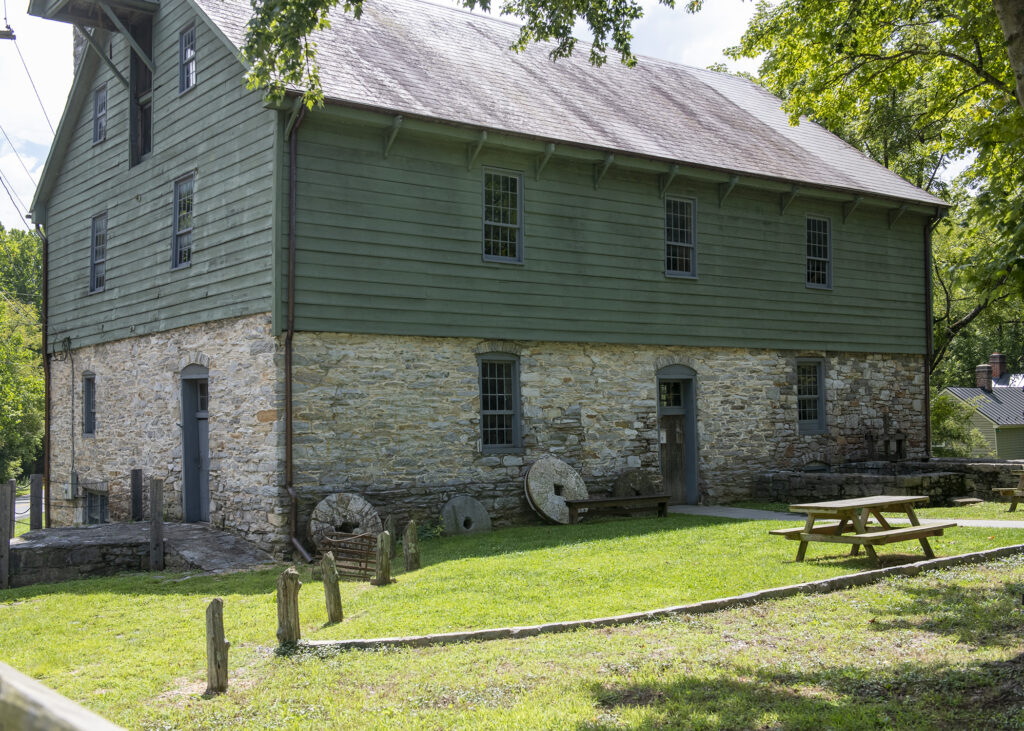
The two founders – Nathaniel Burwell (1750-1814), a Tidewater planter and great grandson of former royal governor of Virginia, Robert “King” Carter, and Daniel Morgan (1736-1802), honored Revolutionary War hero and wagoneer – came together to initiate the project in the tiny hamlet of Millwood, just 23 minutes from Middleburg.
Art Old and New
The mill itself is a piece of art. Its lower portions are built of rugged, native limestone, and a walk through the front door opens to 200-year-old scroll and block lettering on the rustic walls. The structure is listed on both the National Register of Historic Places and the Virginia Landmarks Register.
Twice a year, the mill transforms into an art venue for the Art at the Mill show. Fine art in various forms – paintings, metalwork, pottery, ceramics, woodwork, and sculptures – is on display and for sale from over 300 gifted artists near and far. The 2022 fall show will be held from October 1 to 16. Patron’s Night, a ticketed evening gala event that includes local eats and spirited beverages, will kick off the exhibit on September 30.
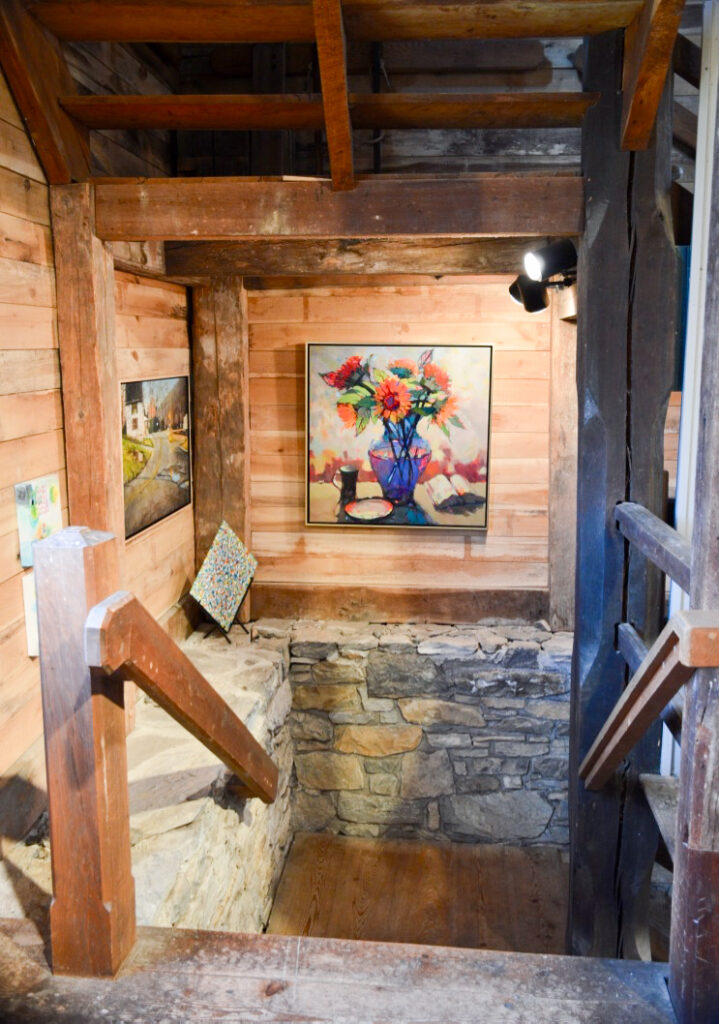
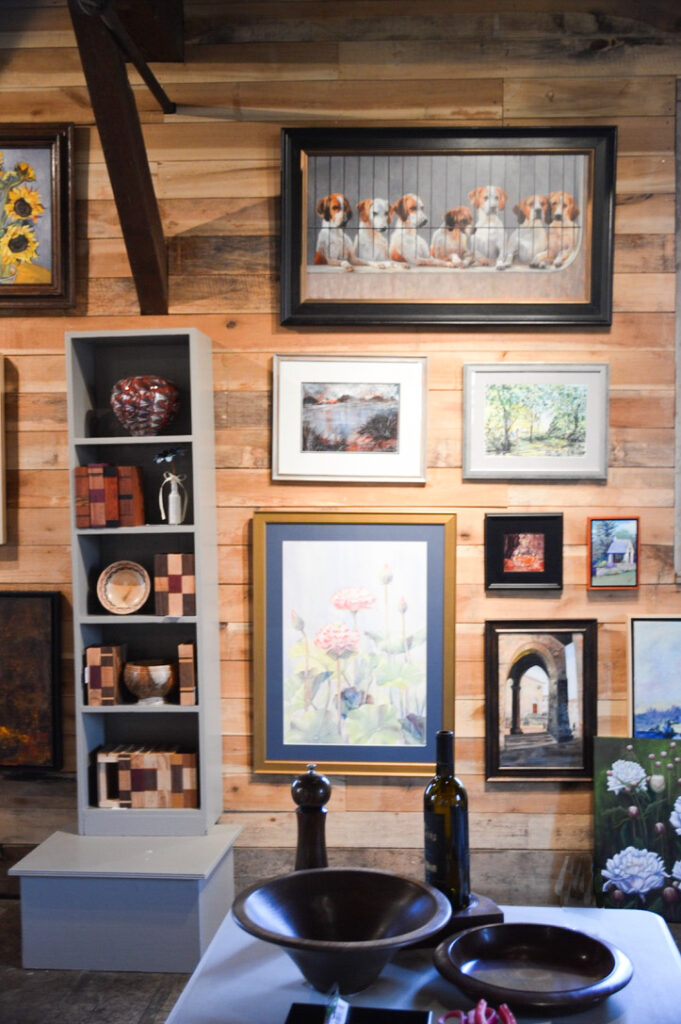
Nathan Stalvey is the director of the Clarke County Historical Association (CCHA), the organization that owns the mill. Stalvey earned a Master of Arts in Public History and Museum Management and a Bachelor of Arts in History from the University of South Carolina where he worked as curator of traveling exhibits and graphic design at McKissick Museum.
“Art at the Mill is our primary fundraiser,” Stalvey says. “Funds generated help keep the water wheel turning now and for future generations so they can understand the important history it plays in the story of Clarke County and the Commonwealth of Virginia.”
Kathy Campbell is a former CCHA board president and in the past has chaired the art show committee. She lives in neighboring Boyce and is an artist who taught art at Clarke County High School for 12 years.
“The first [art] show was in 1990; it started as an idea to raise money for the mill’s restoration,” Campbell explains. “We have a little bit of everything in the art pieces: horses, barns, landscapes, foxes, nature scenes, abstract art. The jury works hard on picking different things to showcase. A whole team of people set up the show which includes hanging each piece (a puzzle in itself). This team is led by Snow Fielding who has been involved with the show in many capacities since the early days.”
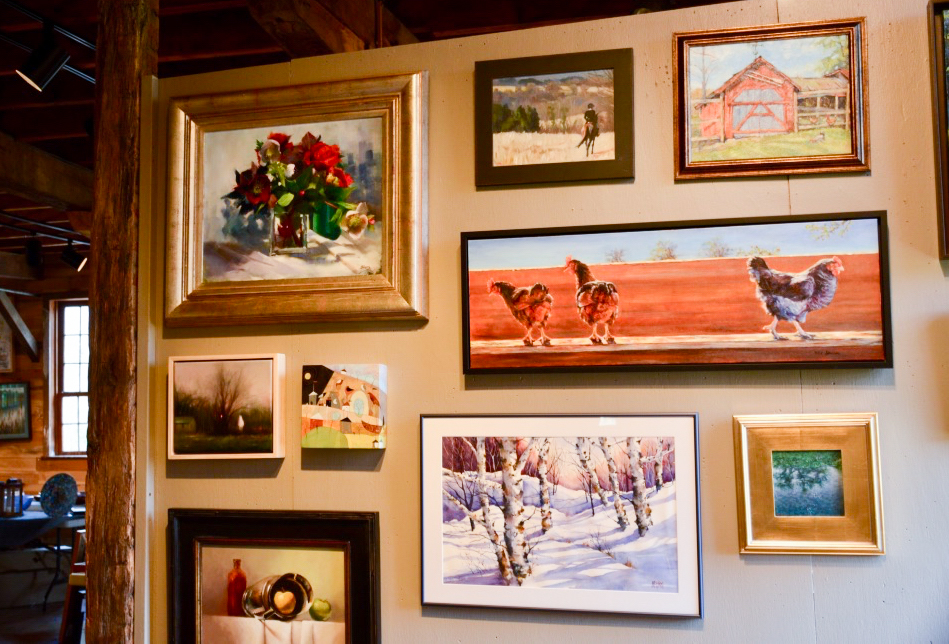
Kathy Hudson of Berryville is on the CCHA board and currently chairs the art show committee. “We get local artists and many others from out of state,” she notes. Hudson came to Clarke County in 1985 from Pennsylvania. When she first spotted the mill, she remembers, “I was instantly enamored and taken with the area’s history.” She credits the mill as the reason she chose to stay in Virginia.
“Over the years, the caliber of the art [has been] amazing,” Hudson says. Local artist Gwen Casey-Higgins supports the art shows behind-the-scenes by responding to artists’ inquiries and handling all the advertising. “She’s my right-hand person; I’d be lost without her,” Hudson shares.
The show is juried, requiring artists to submit photos of their work for possible inclusion. Art is displayed on the main and upper levels; extra wall units are installed for additional space to hang the multitude of pieces. “People make it an annual event to come here,” Hudson says. “Art is one way to bring people together.”
The Mill’s History
The mill was built between 1782 and 1785 when the changing economy in Europe caused a sudden demand for grains. With Burwell’s 8,000 acres, he had the land, but he needed a partner. Enter Daniel Morgan.
Before the war, Burwell was a 1774 graduate of the College of William and Mary. Morgan was from the north but his exact birthplace is unknown; he lacked a formal education and was a farmer. He became an experienced wagoneer who hauled freight to the eastern part of the Virginia Colony. Though Burwell and Morgan had very different starts in life, they shared one thing: their military service in the Revolutionary War (1775-1783).When Burwell chose Morgan as his business partner, he had already known of Morgan’s success in the military and as a businessman. Thus began a partnership between the Colonel and the General.
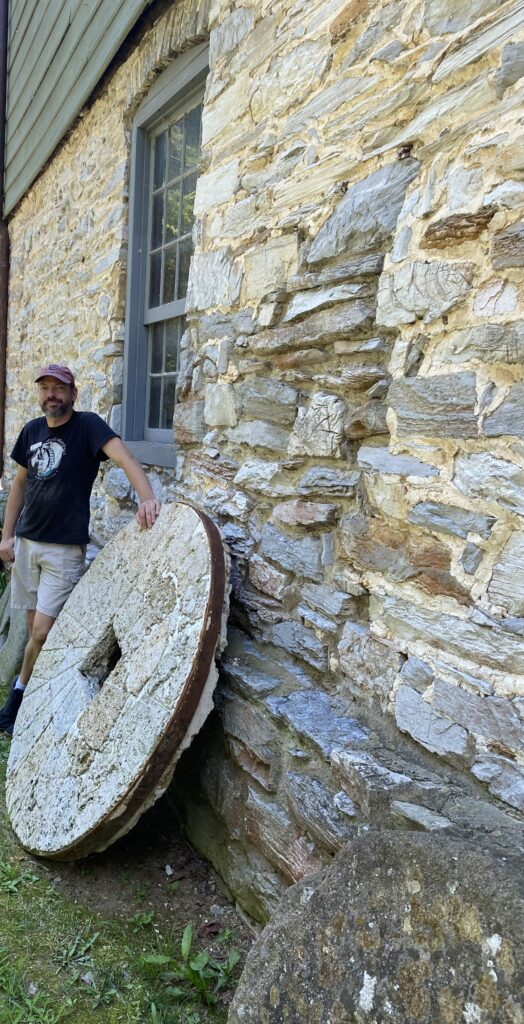
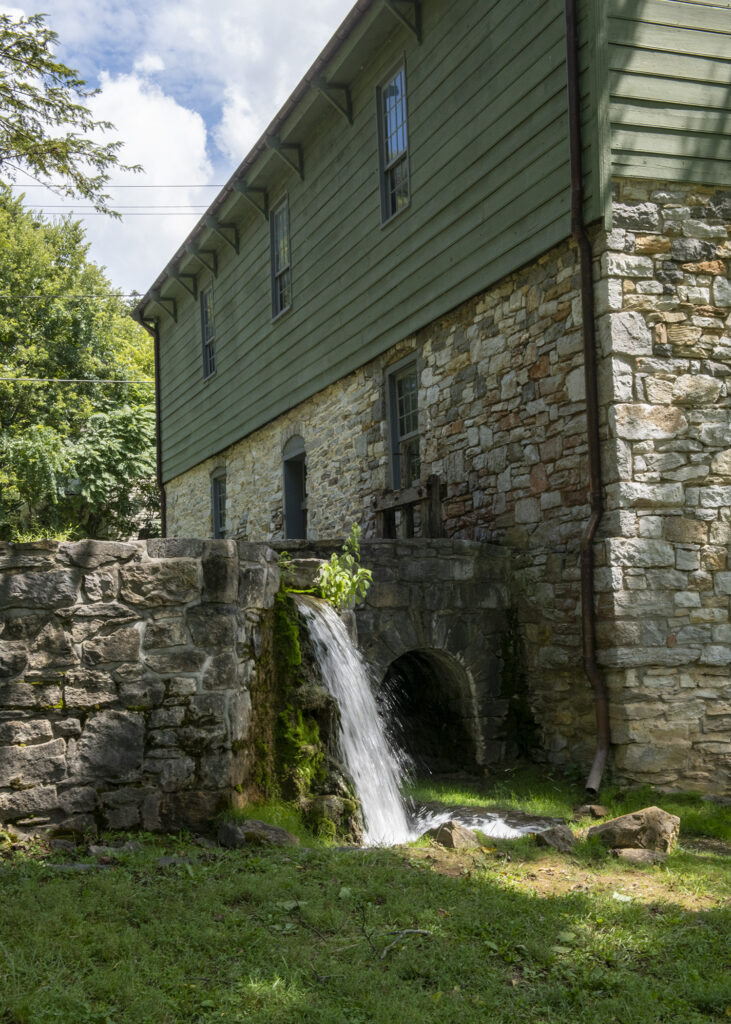
The lowest level of the four-story mill houses the mechanical gears including the huge wooden water wheel that is 20 feet in diameter and turns the French buhr stones on the main level for grain grinding. These gears rotate as a result of falling water provided by Spout Run.The wooden third and fourth stories were added in 1877.
“The mill’s number one purpose was to make money. This mill was used for mass production. Its [products] were put in hogshead [barrels] for export,” Stalvey shares. Flour produced here was sent to ports in Alexandria and Dumfries for shipment to Europe and the West Indies.
According to the 1969-1970 “Proceedings of the Clarke County Historical Association: The History of The Millwood Mill 1782-1785” booklet, the area “mushroomed into a thriving post-Revolutionary village with the large merchant mill as its economic heart, including also a tanyard, a fine extensive manufactory of leather, a boot and sow maker, a large store, a tailor, a blacksmith, a waggoner, one tavern, two distilleries, and a post office.”
Carl Maples of Berryville has volunteered at the mill for 20 years. “The Buttery [Restaurant] across the street was originally the grog shop,” he confirms. “That’s where they stored barrels [of spirits].”
On Saturday mornings, local volunteer millers and Stalvey stay busy grinding various grains including corn varieties, buckwheat, rye, nine-grain, and wheat, all of which are available for purchase at the mill. The mill also sells recipe books so customers can bake up a fresh batch of bread at home. According to Jess Foltz, wine manager at the Locke Store across the street, “The Buttery uses the mill’s rye flour in their sourdough breads.”
In addition to owning the 18th-century mill, CCHA owns two more 19th-century structures on the property: the miller’s house and a tollhouse that allowed paying passengers through on what was then a section of the original U.S. Route 50. The meadow surrounding the mill is an inviting space with picnic tables dotted around Spout Run, a tributary of the Shenandoah River.
Preservation for Future Generations
To walk around this mill is to witness the vision of Burwell and Morgan and appreciate the investment and hard work by many villagers to make it a success. As the nation was just breaking free from Britain, the mill was busy providing a valuable resource for those who lived here.
Stalvey points out, “Millwood sprung up around this mill and was a center of economic activity. In its heyday, the mill served as a local gathering place. And it continues to serve as an anchor for Millwood, bringing in people from all over. Making sure the mill is preserved and operational for present and future generations is at the very heart of CCHA’s mission.”
With regard to the art show, Hudson emphasizes, “It’s a labor of love for the mill and the community.”
Burwell-Morgan Mill is located at 15 Tannery Lane in Millwood. For tickets to Patron’s Night, (September 30, 6 – 9 p.m.) and more information on Art at the Mill (October 1 – 16, Saturdays 10 a.m. – 5 p.m. and Sunday through Friday, 12 p.m. – 5 p.m.), please visit: clarkehistory.org/art-mill.html. ML
This article first appeared in the September 2022 issue.








